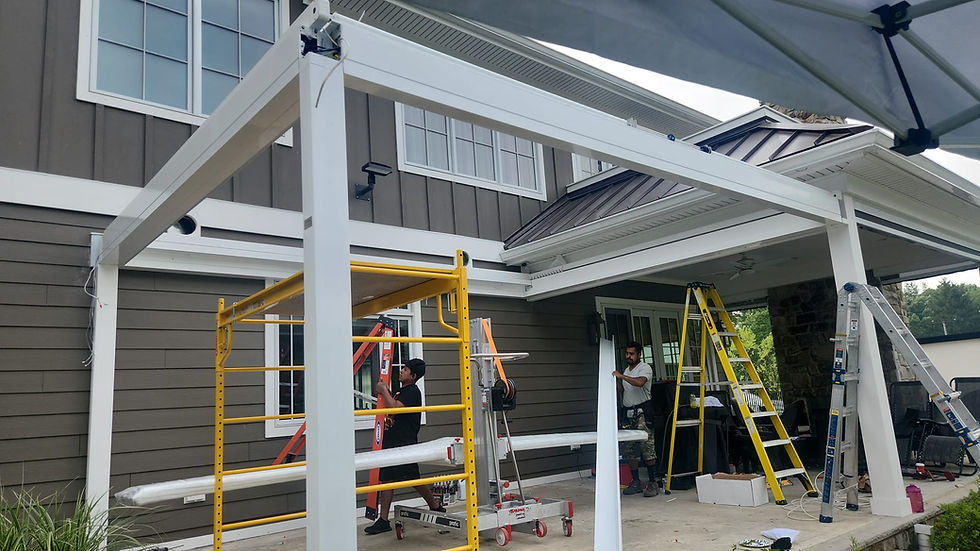When Your Contractor Says “It’s Just a Beam” — Why That’s Usually a Problem with Outdoor Structures Design in New York
- Privlux Inc.
- Jul 18
- 3 min read
Why a Beam Matters More Than It Looks
Clients often hear, “It’s just a beam,” when their contractor points to a segregate pergola header or supporting girder. However, that oversight overlooks how critical precise outdoor structures design in New York is—especially when dealing with systems like Luxshade, Visualize, and Uptrack. A slight misalignment in the framing can lead to hardware conflicts, rain seepage, motor strain, and early failure. Let’s dig into what can go wrong—and why it’s worth calling “just a beam” dangerous.

1. Misalignment & Squareness — A Subtle Setup That Spoils Rain & Motion
Pergolas like Visualize Basic or Plus, with their rotating blades, require squared and level beams. If the headers shift even 1/8″ over 10 ft, blade seals no longer align, water leaks in, or the motor struggles—resulting in rattling or breakage. Similar logic applies to Carrera’s hybrid blade system: misalignment introduces uneven pressure when rotating and stacking blades, reducing lifespan and granting mid-season repairs.
2. Beam Twist or Deflection — Invisible Forces in Wind Loads
Aluminum pergola beams flex more than girder beams, but that flexibility isn’t always benign. In windy zones, a poorly supported beam in systems like Luxshade or Uptrack—both roofed with tensioned fabric—can twist. This distorts fabric retraction paths or sleeve tracks, causing binding with specialist hardware. The result? Fabric fraying and motor overload. Structural guides recommend larger beam sections or braces to combat deflection under wind pressure
3. Sagging Over Spans — Leads to Pooling or Bowing
Even a seemingly straight beam will sag over long spans. That small deflection can turn rainwater into ponding, especially on Luxshade’s flat fabric and Uptrack’s inclined PVC surface—and ice buildup in winter compounds the problem. Manufacturer recommendations often specify limiting span lengths to prevent sag; ignoring those specs means reduced life expectancy.
4. Grid Errors from Uneven Slabs or Footing Placement
Beams anchored on uneven foundation surfaces—for example, variable slab heights—create inconsistent post spacing. On louvered systems, this misplacement results in out-of-square rafters. It’s the same problem noted by experts in StruXure’s pergola installation guides: “Ensure alignment… while securing to maintain structural integrity” (). For homeowners seeking a durable system in NYC’s variable terrain, this matters.
Privlux Pergolas — How Each Reacts to Poor Beam Conditions
• Solidare’s fixed vinyl roof requires perfect beam alignment. Twist or droop leads to wrinkles in the fabric canopy, no vendor-adjustments, and early replacement—no motor part to blame.
• Uptrack, with its inclined fabric roof, is vulnerable to beam misplacement. Even slight beam tilt twists retraction and drainage, causing water pooling and motor friction.
• Luxshade, with its flat fabric function and vertical shade integration, demands rigid horizontals and plumb verticals. Beam bowing can introduce fabric sag, motor stall, or gutter overflow.
• Skyview, with a mechanically retractable aluminum roof, requires its header beams to be both square and level. Misalignment causes blades to bind, retraction stops, motors overheat, and leak potential increases.
• Carrera depends on both fixed and rotating blades. Its structural cross-members must enable blade alignment exactly, or the hybrid system fails from friction or mis-stack.
• Visualize, with rotating blades and optional enclosure, cannot function properly unless the roof plane remains level and the perimeter beams are flush with installation surfaces. Misalignment impacts both blade sealing and vertical shade operation.
How to Avoid “Just a Beam” Mistakes
1. Specify Beam Tighter Tolerances than typical framing. 1/16” over 10 ft can break seal performance.
2. Use strong connection plates, diagonal bracing, or gusset fittings—especially for wide spans prone to twist.
3. Verify post-footing levels before fastening headers. Shim or adjust post heights to ensure a flat beam.
4. Load-rate beams for wind and snow. Systems like Skyview/louvered pergolas add concentrated roof load—require proper structural grade.
5. Inspect periodically. Even small beam shifts can create cascading issues in roof function, motor wear, or fabric tension.

The Takeaway for Homeowners: Dealing with Outdoor Structures Design in New York
When your contractor dismisses a beam as just another part—it’s more than cosmetic. With advanced pergola systems, outdoor structures design in New York depends on rigid, plumb framing. Failure to address alignment, deflection, or anchorage isn’t just sloppy work—it’s a reduced lifespan, compromised warranty, and lifestyle disappointment.
Investing a little more time in beam and framing checks means your Luxshade, Visualize, Uptrack, Skyview, Carrera, Solidare, or Visualize Basic perform as promised: smooth, dry, durable, and dependable.

Final Thought
Don’t let “just a beam” derail your pergola experience. The real installation is invisible—but its effects are front and center when things go wrong. When precision matters, insist on better framing—not excuses. For site-specific framing reviews or installation oversight, contact Privlux Inc on Whatsapp 833 774 8589. We bring New York conditions and pergola engineering together—so your shade works right, from day one.
_edited.png)



Comments